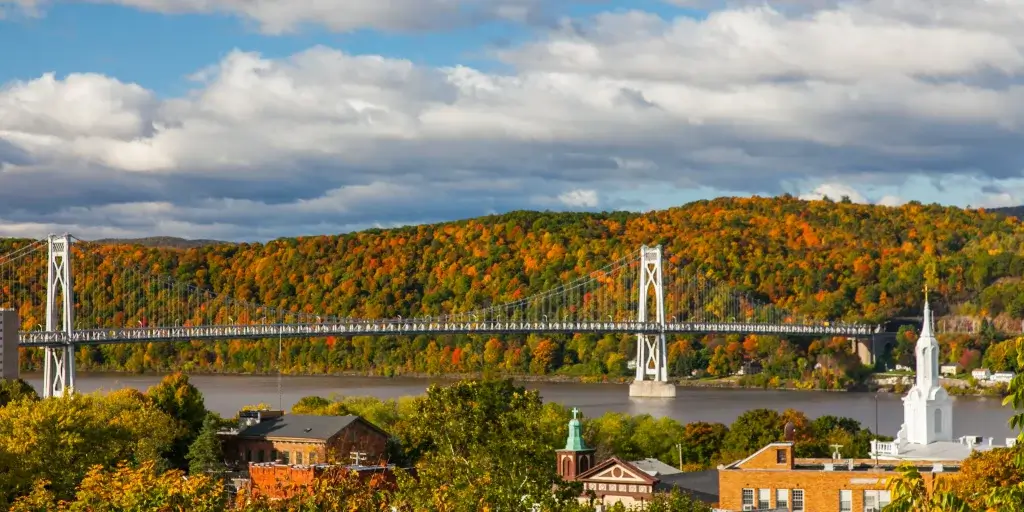The Hudson Valley region, located in the state of New York, has long been known for its rich history, beautiful landscapes, and charming small towns. However, in recent years, the Hudson Valley has experienced a significant boom in popularity, with more and more people moving to the area and seeking out real estate opportunities.
There are a few key factors that have contributed to this Hudson Valley boom in 2021. The first and perhaps most significant factor is the ongoing pandemic, which has led to a major shift in the way we work and live. With more people working remotely or seeking out a change of scenery, the Hudson Valley has become an attractive destination for those looking to escape the crowded and expensive cities.
The Hudson Valley’s small towns and rural communities have also played a role in its recent boom. With a growing interest in sustainable living and a desire to be closer to nature, the Hudson Valley’s many charming towns and sprawling countryside have become highly sought-after. Additionally, the region is home to a plethora of outdoor recreation opportunities, from hiking and biking trails to fishing and hunting, which have only become more appealing as people seek out ways to enjoy the great outdoors while still practicing social distancing.
Another factor driving the Hudson Valley boom is the region’s growing reputation as a hub for sustainable living. The Hudson Valley is home to a number of farm-to-table restaurants, farmers markets, and local food producers, making it a great destination for those interested in supporting local agriculture and reducing their carbon footprint.
All of these factors have combined to make the Hudson Valley a highly desirable place to live, and as a result, the region has seen a significant increase in real estate prices and demand. In some areas, it has become almost impossible to find an affordable home, as demand has outpaced supply.
While the Hudson Valley boom has brought many economic benefits to the region, it has also had its share of challenges. The influx of new residents has put a strain on local infrastructure and resources, as the region struggles to keep up with the demand for housing, schools, and other amenities.
The Hudson Valley’s culture and community have also been impacted by the boom. As more people move to the region, the local population becomes more diverse, and there are bound to be some growing pains as different groups try to find common ground.
So what does the future hold for the Hudson Valley boom? It’s hard to say for certain, but it seems likely that the trend will continue, at least for the foreseeable future. The pandemic has permanently changed the way we work and live, and the desire for small towns, rural living, and sustainable communities is unlikely to disappear anytime soon.
However, there are also potential challenges and drawbacks to consider. As more people flock to the Hudson Valley, there is a risk that the region could become overcrowded and lose some of its charm. There are also concerns about the impact of the boom on the local environment and economy, as the region struggles to balance the needs of its new residents with the needs of its existing communities.
To address these issues, the Hudson Valley is taking steps to plan for its future growth. Local governments are working to create new policies and regulations to ensure that the region’s infrastructure and resources are able to support its growing population, and community groups are working to promote sustainable living practices and preserve the region’s natural beauty.
In conclusion, the Hudson Valley boom of 2021 has brought both benefits and challenges to the region. While it has brought new economic opportunities and a diverse population, it has also put a strain on local infrastructure and resources and changed the local culture and community. It remains to be seen how the Hudson Valley will adapt to its growing popularity, but with careful planning and a commitment
The Causes of the Boom
The Hudson Valley region of New York has recently experienced a surge in population and real estate prices. The impact of the pandemic, the popularity of small towns and rural living, the abundance of natural beauty and outdoor recreation opportunities, and the growing interest in sustainable living are all factors that have contributed to this trend.
The increase in remote work as a result of the pandemic has been a major contributor to the Hudson Valley boom. With many companies and employees shifting to remote work, there is more freedom in where people can live and work. More people have been able to leave the city and relocate to smaller towns and rural areas, such as the Hudson Valley, where they can have more space and a lower cost of living.
In addition to an increase in remote work, there has been a recent trend toward small towns and rural living. Many people are looking for a more relaxed, community-oriented lifestyle and are drawn to the slower pace of life found in small towns. The Hudson Valley, with its charming towns and villages, has proven especially appealing to those looking to relocate to a smaller community.
Another factor that has contributed to the Hudson Valley’s growth is the region’s abundance of natural beauty and outdoor recreation opportunities. The Hudson Valley is home to numerous lakes and waterways, as well as beautiful parks, forests, and trails. As a result, it has become a popular destination for those who enjoy spending time outdoors and participating in activities such as hiking, biking, and fishing.
In addition to the region’s natural beauty, there has been a growing interest in sustainable living in recent years. Many people want to live in a more environmentally friendly way that reduces their carbon footprint. The Hudson Valley, with its abundance of local farms and opportunities to live a more self-sufficient lifestyle, has drawn those seeking a more sustainable way of life.
Overall, the 2021 Hudson Valley boom can be attributed to a number of factors, including an increase in remote work, the popularity of small towns and rural living, an abundance of natural beauty and outdoor recreation opportunities, and a growing interest in sustainable living. All of these factors have contributed to the influx of new residents and the rise in regional real estate prices. It will be interesting to see how these trends shape the Hudson Valley over the next few years.
The Impact of the Boom
One of the most significant impacts of the Hudson Valley boom in 2021 has been the increase in real estate prices and demand. As more and more people have flocked to the area, looking for rural retreats or places to work remotely, the demand for housing has skyrocketed. This has led to a sharp increase in home prices, as well as a competitive market for buyers.
In some cases, homes are being sold for significantly more than their original asking price, as buyers compete to secure a property in the Hudson Valley. This has been a significant financial benefit for many homeowners, who have seen the value of their property increase significantly in just a few short months.
However, not everyone has benefited from this increase in real estate prices. For those who were already struggling to afford housing in the area, the rapid increase in prices may have made it even more difficult to find a place to live. Some residents have expressed concern that the Hudson Valley boom may lead to gentrification and a displacement of low-income or marginalized communities.
In addition to the impact on real estate prices, the Hudson Valley boom has also put a strain on the region’s infrastructure and resources. As more people have moved to the area, there has been an increase in traffic, leading to congestion on roads and highways. There has also been a strain on public utilities, as more people are using water, electricity, and other resources.
To address these issues, local governments have been working to improve infrastructure and upgrade public utilities. However, it remains to be seen whether these efforts will be sufficient to meet the increased demand.
Despite these challenges, the Hudson Valley boom has also brought significant economic benefits to the region. The influx of new residents has led to an increase in business and tourism, boosting the local economy. Many small businesses have reported a significant increase in sales, and there has been a surge in the number of new businesses opening in the area.
In addition to the economic benefits, the Hudson Valley boom has also brought about significant changes in the local community and culture. With an influx of new residents from different backgrounds and cultures, the region has become more diverse and dynamic. This has led to a greater sense of community and a more vibrant cultural scene, as new residents bring with them new ideas and perspectives.
However, some long-time residents have expressed concern that the changes brought about by the Hudson Valley boom may erode the region’s sense of identity and history. There is a fear that the influx of new residents may lead to the loss of the area’s small-town charm and character.
Overall, the Hudson Valley boom of 2021 has had a significant impact on the region, with both positive and negative consequences. While there have been significant financial benefits and an increase in business and tourism, there have also been challenges related to the strain on infrastructure and resources and the potential for gentrification and displacement. It remains to be seen how the Hudson Valley will continue to evolve in the coming years and how these issues will be addressed.
The Future of the Hudson Valley Boom
Ultimately, when deciding on an appropriate tip, it is critical to consider the value of the services provided by your movers. Tipping is a common way to express gratitude for your movers’ hard work and excellent service. When deciding how much to tip, consider the length of the move, the difficulty of the move, the quality of the service, and your budget. Moving industry standards for tipping movers typically range from $20 to $40 per mover for a full-day move, but these amounts can vary depending on the specific circumstances of your move.
Other than a monetary tip, there are other ways to show your appreciation for your movers, such as providing drinks or snacks during the move or leaving a positive review for their company. It is also a good idea to have a budget set aside in advance for tipping and to divide the tip evenly among the moving team, giving it to each individual and thanking them individually. If the movers make unreasonable demands for the tip or behave badly, it is best to contact the moving company to resolve the situation.
Overall, it is critical to recognize the value of the services provided by your movers and to express gratitude for their efforts. Moving can be a stressful and difficult process, and the assistance of professional movers can make a significant difference. Tipping is a way to express gratitude for their efforts and to let them know that their work is valued and appreciated. By following these guidelines, you can avoid the stress and awkwardness of deciding how to handle the end of your move and express your gratitude in a meaningful way.




